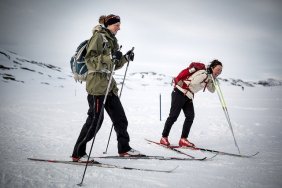 In Part One of this series, we took a look at some basic tips you should keep in mind to prepare yourself for cross-country skiing, such as keeping a backpack on hand and prepping your skis with wax. Today, we’ll go a little further and explore some hints for when you actually hit the snowy trails.
In Part One of this series, we took a look at some basic tips you should keep in mind to prepare yourself for cross-country skiing, such as keeping a backpack on hand and prepping your skis with wax. Today, we’ll go a little further and explore some hints for when you actually hit the snowy trails.
It helps to stretch before and after cross-country skiing. This helps keep you flexible and will also decrease the potential for muscle soreness. Gently stretch your quads, hamstrings, gluteus muscles, and your calves. Also, since skiing works out your arms, too, don’t forget your biceps and triceps. Start out by stretching slowly, as this will allow you warm up properly.
If you’ve never given cross-country skiing a try, it will help immensely if you practice the techniques before hitting the trails. Find a gentle slope in a safe area where you can practice climbing and descending (known as the herringbone and snowplowing techniques, respectively), and then move on to tougher techniques, such as snowplow turns. As you get faster on your descents, you will want to learn to do step turns.
With the aforementioned form and technique tips in mind, it’s now time to make sure you protect yourself from the sun. Even on overcast days, reflected light off the snow and prolonged exposure can cause burns or snow blindness. To prevent this, be sure to wear sunscreen and sunglasses that offer UV protection. Also, it’s important to drink plenty of water, and drink it regularly, even if you don’t feel thirsty. Staying hydrated also helps you to stay warm.
If it’s your first time, head to a Nordic ski center and be sure to inform the on-duty staff that you’re new to the activity. Don’t be afraid to ask about the rules, trail etiquette, and trails best suited to your skiing ability, also. The staff will appreciate your openness, and taking the time to learn all this vital information will greatly reduce the potential for any problems out on the trails.








